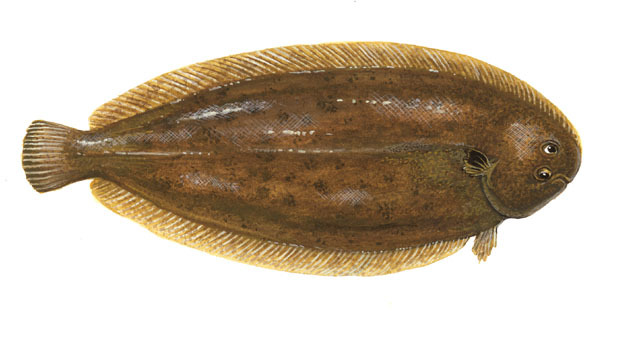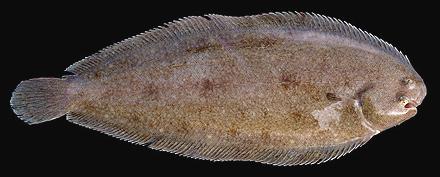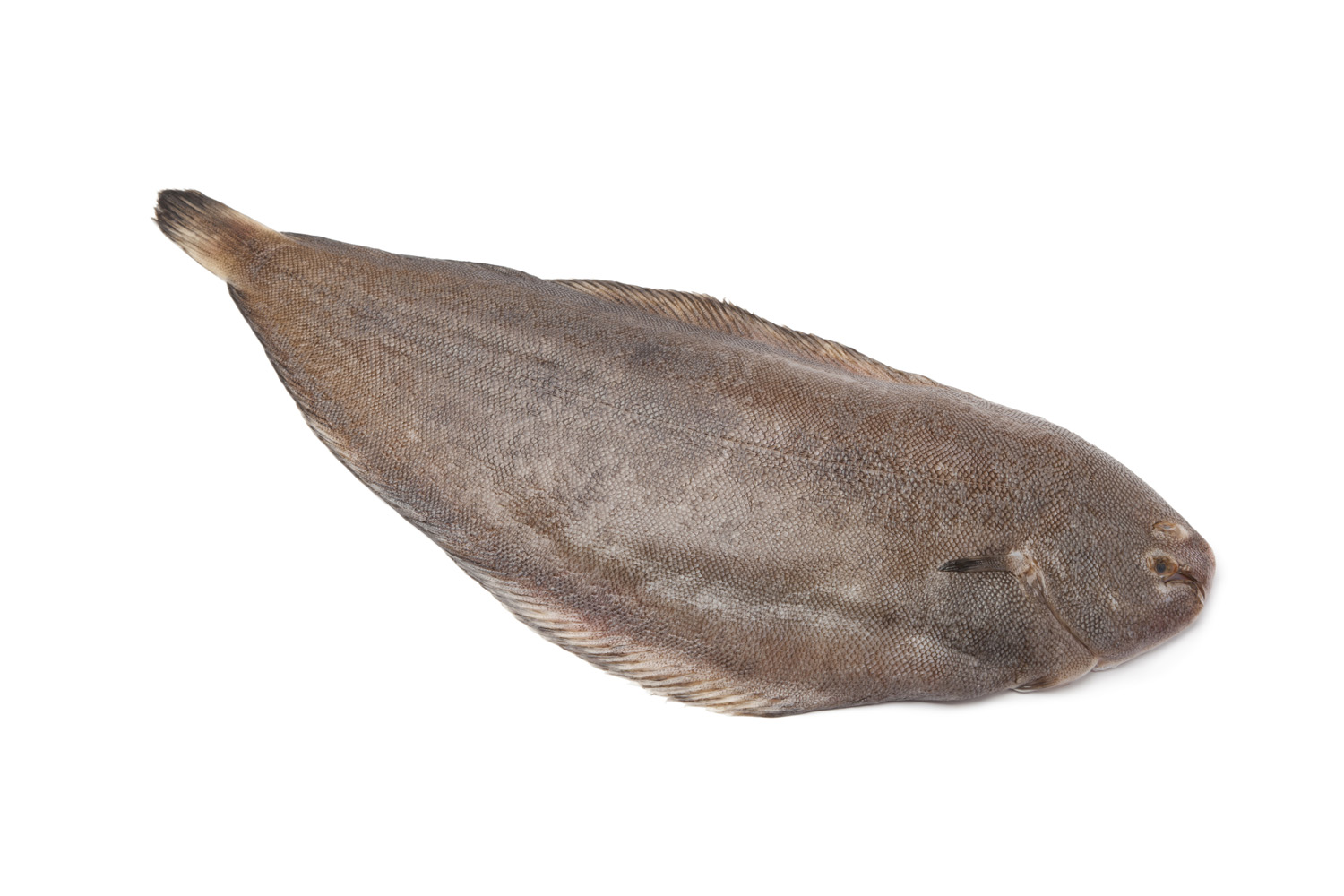
Solea solea
FAMILY
Soleidae
TAXONOMY
Pleuronectes solea Linnaeus, 1758, European ocean.
OTHER COMMON NAMES
English: Dover sole; French: Sole commune; German:
Seezunge; Spanish: Lenguado commъne.
PHYSICAL CHARACTERISTICS
Dextral flatfish with an elongate but rather thick body. The
dorsal fin extends to the anterior part of the head, often to a
point equal to a horizontal line drawn through the upper eye.
Has a smoothly rounded head, projecting snout, and a small,
subterminal mouth with small teeth and with the preoperculum
covered by skin. On the blind side, head and snout are
covered with close-set, whitish sensory papillae. Moderately
large pectoral fins. On the ocular side this fin has a distinct elliptical
black patch (not surrounded by white ring) on its upper
extremity. On the blind side it is only slightly smaller than
the ocular side counterpart. Last rays of the dorsal and anal
fins are joined to the base of the caudal fin by a distinct membrane,
and the last rays of the dorsal and anal fins overlap the
bases of the caudal fin rays. Ocular side is uniformly dark
brown or grayish brown, with numerous darker irregular
blotches. Dorsal and anal fins are edged in white. Blind side is
creamy white. Lengths reach about 27.6 in (70 cm) and
weights about 6.6 lb (3 kg), but most fish are 11.8–15.7 in
(30–40 cm) in length. They attain ages up to seven to eight
years and perhaps older.
DISTRIBUTION
Northeastern Atlantic in estuarine and marine waters from off
Norway and the western Baltic Sea and commonly off Ireland,
England, and Scotland (uncommon northwest of Scotland).
Also commonly along the European coast in the southern
North Sea, the Mediterranean Sea, and the eastern Black Sea
and southward to Senegal.
HABITAT
Occurs on soft sandy or muddy bottoms over a wide range of
salinity levels and depths, ranging from shallow estuarine waters
of 3.3 ft (1 m) or less down to about 656 ft (200 m). Estuaries
are important nursery areas for newly settled fish and
juveniles. Young-of-the-year soles appear in surf zone waters
on shallow sandy beaches during summertime and can be
taken even in shallow tide pools during this time. They occur
at temperatures from 46.4 to 75.2°F (8–24°C). Adults and
larger juveniles undertake seasonal migrations between shallower
waters on the inner shelf (in warmer periods) to deeper
areas (230–427 ft, or 70–130 m) on the outer shelf in winter.
Larger fish generally are found in deeper waters than are
smaller fish. Seasonal inshore migrations during springtime
are complicated, because larger fish, besides moving inshore,
also move toward definite spawning grounds. Young fish move
into inshore waters earlier, usually during spring, whereas
larger fishes move into shallower waters by late spring or early
summer.
BEHAVIOR
Benthic fishes that live somewhat solitary lives. They spend
much of the daylight hours partially buried in sediments or lying
on top of them. In overcast conditions or in turbid waters,
such as in estuaries, they are more active during daylight
hours. Generally, they are most active at nighttime, when they
sometimes are found off the bottom and up in the water column.
They are found pelagically during migrations.
FEEDING ECOLOGY AND DIET
Opportunistic, nocturnal feeders that rely on chemosensory
and tactile information to locate their prey. Some feeding by
adults and juveniles also takes place during daylight hours
when fish are active. In some estuaries, feeding activity showed
a strong relationship to the tidal cycle. Juveniles may use intertidal
areas as feeding grounds during flood tides. They consume
a diverse array of mostly benthic prey, including
amphipods, polychaetes, oligochaetes, small bivalve mollusks
and siphons of bivalve mollusks, gastropod mollusks, mysids
and crangonid shrimps, brittle starfish, and, to a lesser extent,
small benthic fishes, such as sand eels (Ammodytes) and gobies.
Diets often vary between habitats and in terms of size of fish,
with prey sizes generally increasing with increasing fish size.
Soles feed on small quantities of prey very often. Predators of
sole include spiny dogfish, hakes, lizardfish, codfish, weaver
fish, and cormorants.
REPRODUCTIVE BIOLOGY
Mature at three to five years of age and at sizes of about
9.1–11.8 in (23–30 cm). Spawn primarily during one welldefined
season in the spring and early summer, which varies
according to latitude (March to May off England and April
to June farther north). Spawning grounds are located in both
shallow and deep waters. Spawning takes place between 42.8
and 53.6°F (6–12°C). Females may release up to 100,000 eggs
during a spawning event. Eggs are buoyant and pelagic; planktonic
larvae hatch when eggs reach a length of about 0.12–0.16
in (3–4 mm). Metamorphosis occurs at about 0.47–0.59 in
(12–15 mm), with settlement taking place at 0.59–0.7 in (15–18
mm) in length. Adults undertake migrations to definite spawning
grounds located on the inner continental shelf at depths of
131–197 ft (40–60 m). Spawning grounds have been identified
in the North Sea, the Irish Sea, and the English Channel.
CONSERVATION STATUS
Not threatened. Stock sizes have been reduced owing to overfishing.
At present, efforts have focused on limiting fishing
pressure and reducing mortalities, with expectations that stock
sizes will not decline further.
SIGNIFICANCE TO HUMANS
Abundant and valued food species. The most valuable fishing
grounds lie in the southern and central North Sea and the Bay
of Biscay. Little recreational fishing occurs, primarily because
of this species’ nocturnal feeding habits and also because of the
difficulty in catching it.
Photo Gallery of - Common sole





 Animalia Life
Animalia Life